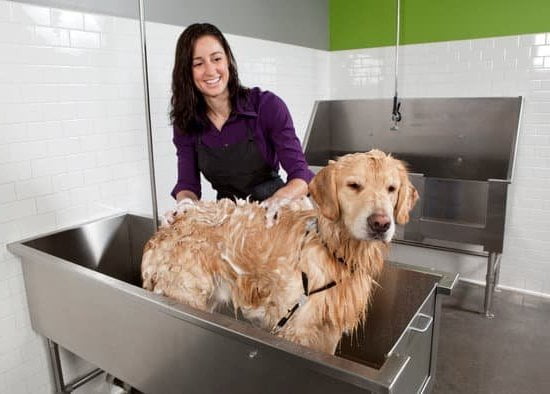If you have ever witnessed the joy and comfort that a therapy dog brings to those in need, you understand the profound impact these furry companions can have. Training your dog to be a therapy dog not only benefits others but also promotes their overall well-being and strengthens the bond between you and your pet. But where should you go to train your dog for this special role?
Therapy dogs play a vital role in providing emotional support, companionship, and affection to people in various settings such as hospitals, schools, nursing homes, and rehabilitation centers. These gentle four-legged friends have a remarkable ability to bring smiles, alleviate stress, and brighten someone’s day with their mere presence. Whether it’s by lending a listening ear or offering gentle nudges of comfort, therapy dogs create an atmosphere of love and healing.
The process of training your dog to become a therapy dog involves specific techniques and skills that extend beyond basic obedience training. It requires patience, consistency, and dedication from both you and your canine companion. Finding the right training facility equipped with experienced trainers who understand the unique requirements of therapy dog certification is essential. In this article, we will explore top-recommended training centers where you can guide your dog towards becoming an extraordinary therapy dog.
What is a Therapy Dog and How Can They Make a Difference?
A therapy dog is a specially trained animal that provides comfort, affection, and support to people in various settings such as hospitals, nursing homes, schools, and therapy sessions. These dogs are known for their patient and calm demeanor, making them ideal companions for those in need of emotional support. They can make a significant difference in the lives of individuals by providing physical and emotional benefits.
One of the key ways therapy dogs make a difference is through the positive impact they have on mental health. Interacting with a therapy dog can help reduce feelings of stress, anxiety, and loneliness. The presence of a friendly and well-trained dog can also stimulate conversation and social interaction among individuals who may otherwise feel isolated or withdrawn.
Therapy dogs also play a role in physical therapy and rehabilitation. For example, they can assist patients undergoing physical rehabilitation exercises by providing motivation and encouragement. Additionally, the act of petting or cuddling a therapy dog has been shown to lower blood pressure and heart rate, promoting relaxation and overall well-being.
In educational settings, therapy dogs can enhance the learning experience for students with special needs or behavioral challenges. Their friendly presence can create a calming environment that encourages focus and engagement in academic tasks. Furthermore, interacting with these dogs can improve communication skills and empathy among children.
Overall, therapy dogs have the ability to provide emotional support, promote socialization, aid in rehabilitation efforts, and enhance educational experiences. Their unique qualities make them invaluable assets within various communities. If you are considering training your dog to be a therapy dog, it is important to understand the potential impact they can have on others’ lives.
Benefits of Training Your Dog to be a Therapy Dog
Training your dog to be a therapy dog comes with numerous benefits, both for the dog and for the people they interact with. The process of training not only enhances your dog’s obedience and skills, but it also provides various opportunities for socialization and personal development.
One of the primary benefits of training your dog to be a therapy dog is the positive impact they can have on others. Therapy dogs are known for their ability to provide comfort, reduce anxiety, and increase well-being in individuals who may be coping with physical or emotional challenges. Whether visiting hospitals, nursing homes, schools, or other facilities, therapy dogs bring joy and companionship to those in need.
In addition to benefiting others, training your dog as a therapy dog can improve their own behavior and temperament. Through training sessions focused on obedience and socialization, dogs become more disciplined and responsive to their owners’ commands. They learn how to interact calmly with different types of people in diverse environments, which helps them become well-rounded and adaptable animals.
Moreover, becoming a therapy dog gives your pet a meaningful job or purpose beyond being a companion at home. Dogs thrive when they have jobs to do as it satisfies their innate need to please and help their human counterparts. The regular interaction with people during therapy visits also builds confidence in dogs and deepens the bond between them and their owners.
| Benefit | Description |
|---|---|
| Provides comfort | Therapy dogs offer emotional support and reduce anxiety in individuals facing physical or emotional challenges. |
| Improves behavior and temperament | Training sessions enhance obedience skills, discipline, socialization abilities, making dogs more well-rounded. |
| Gives dogs a meaningful job | Becoming a therapy dog fulfills their need to help and please, providing them with a sense of purpose. |
Choosing the Right Training Facility
When it comes to training your dog to become a therapy dog, choosing the right training facility is crucial. The success of your dog’s training and their ability to fulfill their role as a therapy dog largely depends on the quality of the training they receive. There are several factors you should consider when selecting a training facility for your canine companion.
One important factor to consider is the experience and qualifications of the trainers at the facility. Look for trainers who have specific expertise in therapy dog training and certification. These trainers should have extensive knowledge of different breeds and temperaments, as well as an understanding of how to properly train dogs for various therapy settings. It may also be beneficial to choose a facility that employs trainers who have experience working with therapy dogs themselves.
Another factor to consider is the curriculum and approach used by the training facility. Different facilities may use different methods and techniques for training therapy dogs. It’s essential to find a facility whose approach aligns with your own values and goals for your dog’s training. Researching and communicating with potential facilities can help you determine whether their methods are positive, rewards-based, and focused on building trust and confidence in dogs.
Additionally, it’s essential to consider the environment offered by the training facility. Dogs need a calm, clean, and structured environment for effective learning. Visit potential facilities in person if possible to get a sense of their space, cleanliness, and overall atmosphere. Ask about class sizes and student-to-instructor ratios to ensure that each dog will receive sufficient individual attention during their training sessions.
By considering these factors when choosing a training facility for your future therapy dog, you can ensure that your four-legged friend receives the best education possible. Taking the time to research multiple options, visit facilities in person, and speak with trainers can help you make an informed decision that will set both you and your furry companion up for success on your journey towards becoming certified as a therapy team.
Top-Recommended Training Centers for Therapy Dogs
Center A: The Pawsitive Training Academy
One of the top-recommended training centers for therapy dogs is The Pawsitive Training Academy. Known for their expertise in positive reinforcement training methods, this facility offers comprehensive programs designed to transform your dog into a therapy dog. The highly skilled instructors at The Pawsitive Training Academy have years of experience in working with therapy dogs and have a deep understanding of the unique needs and requirements of both the dog and handler.
The Pawsitive Training Academy prides itself on creating a positive and supportive learning environment where dogs can thrive. Their curriculum includes obedience training, socialization exercises, and exposure to various environments, sounds, and stimuli to prepare dogs for real-life scenarios they may encounter during their therapy work. Additionally, the center offers specialized classes to address specific needs such as calming techniques for anxious dogs or advanced skills for more experienced teams.
Center B: Harmony Canine Therapy Institute
Another highly recommended training center is the Harmony Canine Therapy Institute. With a focus on holistic approaches to training, this facility believes in fostering a harmonious relationship between dogs and their handlers. The institute offers an array of courses that cover everything from basic obedience to advanced therapy dog work.
Harmony Canine Therapy Institute emphasizes the importance of building strong communication bonds between dogs and handlers through positive reinforcement techniques. Their team of skilled trainers helps dogs develop the necessary skills to provide comfort and support in varied therapeutic settings such as hospitals, nursing homes, schools, and rehabilitation centers.
Center C: Wagging Tails Canine Academy
Wagging Tails Canine Academy is renowned for its comprehensive program that educates both dog owners and potential therapy teams. Their expert trainers focus on cultivating well-rounded therapy dogs who are not only well-mannered but also empathetic towards humans in need.
The academy’s curriculum includes obedience training, proper leash manners, socialization exercises, and specialized courses in animal-assisted therapy. Wagging Tails Canine Academy also organizes regular community outreach programs, allowing the dogs and their handlers to gain practical experience in various therapeutic settings. The facility takes pride in their high success rate of therapy dog placements and has received countless testimonials from satisfied graduates who have witnessed the positive impact their dogs have made in people’s lives.
These top-recommended training centers for therapy dogs offer a supportive and enriching environment to prepare your furry friend for a rewarding career as a therapy dog. Remember to consider factors such as location, training methods, and the specific needs of your dog when choosing a center that best suits you both.
With the right training center by your side, you and your canine companion will be well on your way to creating moments of joy and healing for those in need.
A Closer Look at XYZ Training Center
The Approach of XYZ Training Center
XYZ Training Center has gained recognition as a leading facility for therapy dog training due to their unique approach. Their philosophy centers around positive reinforcement and building a strong bond between the dog and the handler. They believe that by using reward-based training methods, dogs are more likely to retain the skills they learn and exhibit positive behavior in their therapy work.
At XYZ Training Center, trainers understand that every dog is unique and may require different techniques or approaches during the training process. They take an individualized approach to each dog, assessing their personality, temperament, and learning style. This personalized attention ensures that each dog receives the specific guidance and support they need to succeed in becoming a therapy dog.
The Curriculum at XYZ Training Center
XYZ Training Center offers a comprehensive curriculum designed to prepare dogs for all aspects of therapy work. The curriculum covers foundational obedience commands such as sit, stay, down, heel, and come. In addition to these basic commands, dogs also learn more advanced skills like leave it, drop it, loose leash walking, and behavior management techniques.
One of the key components of XYZ Training Center’s curriculum is socialization. Dogs are gradually exposed to different environments, people of all ages and genders, other animals, and various stimuli such as loud noises or crowded spaces. This helps them develop the confidence needed to thrive in diverse therapy settings.
Success Stories from XYZ Training Center
Numerous success stories have emerged from dogs who have trained at XYZ Training Center and gone on to become exceptional therapy dogs. One notable example is Max, a mixed breed rescue who was initially fearful and shy. Through patient training at XYZ Training Center, Max gained confidence over time and eventually became a certified therapy dog.
Another inspiring story is Bella, a Labrador Retriever who underwent training at XYZ Training Center after her owner noticed her natural inclination towards comforting and soothing people in distress. With the guidance of their expert trainers, Bella honed her abilities and now brings joy and comfort to patients in hospitals and elderly individuals in nursing homes.
The success stories from XYZ Training Center not only highlight the effectiveness of their methods but also serve as a testament to how training can transform dogs into valuable therapy companions.
How to Prepare Your Dog for Therapy Dog Training
Preparing your dog for therapy dog training is an important step in ensuring their success in becoming a therapy dog. There are several tips and techniques you can use to help your dog develop the skills and qualities needed for this role.
One of the first things you can do to prepare your dog for therapy dog training is to ensure they have a solid foundation of basic obedience commands. This includes commands such as sit, stay, and come. These commands will not only make it easier for your dog to follow instructions during therapy sessions but also demonstrate their ability to be well-behaved and under control in various environments.
Another important aspect of preparing your dog for therapy dog training is socialization. Exposing your dog to different people, animals, and environments can help them become comfortable and confident in new situations. This can be done through regular walks in parks, visits to pet-friendly stores, or even enrolling them in a puppy kindergarten class.
Positive reinforcement training methods are highly recommended when preparing your dog for therapy dog training. Rewarding your dog with treats, praise, or play whenever they exhibit desirable behaviors will help motivate them and strengthen the desired behavior. Consistency is key when using positive reinforcement, so make sure everyone who interacts with your dog uses the same training techniques.
In summary, preparing your dog for therapy dog training involves focusing on basic obedience commands, socialization, and positive reinforcement training methods. By laying a strong foundation of these skills and qualities, you will greatly increase your chances of success when it comes to therapy work with your furry friend.
| Tips | Techniques |
|---|---|
| Focus on basic obedience commands | Use positive reinforcement training methods |
| Ensure consistency among trainers | Socialize your dog to various environments |
How Long does it Take to Train a Dog to Be a Therapy Dog?
Training a dog to become a therapy dog is a process that requires time, patience, and dedication. The length of time it takes to train a dog to become a therapy dog can vary depending on several factors.
Factors Affecting Training Time
- The Age and Breed of the Dog:
- The Dog’s Previous Training and Experience:
- The Consistency and Frequency of Training:
- Your Level of Commitment:
The age and breed of the dog can influence how long it takes for them to be trained as a therapy dog. Generally, younger dogs tend to be more receptive to training and can learn new skills more quickly. Certain breeds are also known for their intelligence and trainability, which may accelerate the training process.
If your dog has had previous obedience training or has been exposed to various socialization experiences, they may already have some foundational skills necessary for therapy work. This prior training and experience could significantly shorten the time it takes for them to become certified as a therapy dog.
Consistency is key in any type of dog training. Regular, frequent training sessions are essential when teaching your dog the specific skills required for therapy work. Dogs who receive daily training sessions and exposure to different environments typically progress faster than those who receive sporadic or infrequent training.
The amount of time and effort you put into your dog’s training is crucial in determining how long it takes for them to become a therapy dog. Consistently practicing with your dog, reinforcing learned behaviors, and addressing any challenges or setbacks promptly will greatly impact their progress.
While there is no set timeframe for how long it takes to train a therapy dog, on average, it can take anywhere from several months up to a year or more. Each stage of the training process – from basic obedience to advanced skills and evaluations – requires time to ensure that the dog is well-prepared and capable of handling the responsibilities that come with being a therapy dog.
The duration of training also depends on the specific requirements set by different therapy dog organizations. Some organizations may have more rigorous training standards and assessment processes, which could prolong the overall training timeline. It’s important to research and understand these requirements before beginning the training process.
Remember, every dog is unique, and their individual progress will vary. Patience, consistency, and positive reinforcement play vital roles in helping your dog succeed as a therapy dog. Celebrate small victories along the way, and enjoy the journey of bonding with your furry friend while working towards this meaningful goal.
Resources and Support for Therapy Dog Training
When it comes to training your dog to be a therapy dog, having resources and support can greatly enhance the process. Fortunately, there are a variety of books, websites, and online communities dedicated to therapy dog training that can provide valuable information and guidance.
Books on therapy dog training offer in-depth knowledge and step-by-step instructions on how to successfully train your dog for this important role. These books often cover topics such as understanding the temperament and behavior of therapy dogs, training exercises and techniques, and the requirements for becoming a certified therapy dog team. Some recommended books include “Therapy Dogs: Training Your Dog to Reach Others” by Lisa Wiehebrink and “The Power of Positive Dog Training” by Pat Miller.
Websites also provide a wealth of information for those interested in therapy dog training. Many organizations that specialize in therapy dogs have comprehensive websites that offer resources such as training tips, frequently asked questions, and lists of approved trainers or programs.
Additionally, there are websites specifically dedicated to providing information on various aspects of therapy dog training, including the certification process and the benefits of therapy dogs in different settings. One highly regarded website is Therapy Dogs International (TDI), which provides invaluable resources for those interested in therapy dog work.
Apart from books and websites, joining online communities can be incredibly beneficial for both you and your dog during the training process. These communities consist of like-minded individuals who share their experiences, advice, and successes regarding therapy dog training.
Online forums or social media groups allow you to connect with others who are going through or have gone through similar journeys with their own therapy dogs. By participating in these communities, you can gain an abundance of support, encouragement, and knowledge throughout your training journey.
By utilizing these resources including books, websites,and online communities for education,vast support networks,and professional opinions,you are setting yourself up for success when it comes to training your dog to be a therapy dog.Their guidance,motivation,and expertise are invaluable and will help you and your dog work towards becoming a successful therapy dog team.
Conclusion
In conclusion, training your dog to become a therapy dog is a fulfilling and impactful endeavor. The benefits of having a therapy dog are immense, as they can make a difference in the lives of individuals in need. By providing emotional support and companionship, therapy dogs can bring comfort and joy to those who may be experiencing difficult times or facing various challenges.
When choosing the right training facility for your dog, it is essential to consider several factors. Look for centers that have experienced and knowledgeable trainers who use positive reinforcement techniques. Additionally, finding a facility with a curriculum that aligns with your goals and values is crucial. Take the time to research different options and read reviews from other dog owners who have gone through the training process.
Among the top-recommended training centers for therapy dogs, XYZ Training Center stands out for their exceptional approach, comprehensive curriculum, and numerous success stories. With their emphasis on positive reinforcement training methods and personalized attention to each dog’s needs, XYZ Training Center has proven to be highly effective in preparing dogs for therapy work.
Preparing your dog for therapy dog training requires patience and dedication. It is recommended to start with basic obedience training before advancing into more specialized tasks. This includes teaching your dog commands such as sit, stay, come, and walking calmly on a leash. Consistency is key throughout the entire training process.
While the duration of therapy dog training can vary depending on the individual dog’s temperament and skills, it typically takes several months of consistent practice to achieve certification. Owners should view this as an ongoing journey rather than an end point, as continued education and reinforcement are necessary throughout the life of a therapy dog.
Finally, there are various resources and support available to assist you on this journey. Books focused specifically on therapy dog training provide valuable tips and insights from experienced professionals in the field. Online communities offer a platform for sharing experiences and seeking guidance from fellow owners who have trained their dogs as therapy animals.
Overall, embarking on the path to training your dog to be a therapy dog is a noble and rewarding endeavor. By taking the first step towards this goal, you are not only providing an opportunity for your furry friend to make a difference in the lives of others but also forming a deeper bond with your beloved pet. So, with dedication, patience, and the right resources, you can start this remarkable journey with your canine companion today.
Frequently Asked Questions
How long does it take to train a dog to be a therapy dog?
The length of time it takes to train a dog to be a therapy dog can vary depending on several factors. These factors include the individual dog’s temperament, breed, age, and previous training experiences. Generally, it can take several months to a year or more to fully train a dog for therapy work.
The training process involves teaching the dog basic obedience commands, socializing them to different environments and people, desensitizing them to various stimuli, and introducing them to specific therapy dog tasks. Consistency, patience, and positive reinforcement are crucial during this training period. It is recommended to work with an experienced trainer or enroll in a therapy dog program that follows recognized standards.
Is it too late to train my dog to be a therapy dog?
It is never too late to train a dog to be a therapy dog; however, the ease and success of the training may depend on certain factors. Older dogs can still learn new skills and adapt their behavior with proper training techniques and consistent reinforcement.
However, it may take longer for an older dog to grasp new concepts compared to a younger one. Age should not necessarily deter someone from pursuing therapy dog training for their canine companion; instead, they should consider their dog’s temperament and overall health as well as consult with professional trainers or organizations specializing in therapy dogs.
How do I get my dog certified as a therapy dog in Michigan?
To get your dog certified as a therapy dog in Michigan, there are several steps you need to follow. First and foremost, your dog must meet certain requirements set forth by accredited therapy animal organizations such as Therapy Dogs International (TDI), Alliance of Therapy Dogs (ATD), Pet Partners (formerly Delta Society), etc.
These requirements generally include having basic obedience skills, being well-behaved around people and other animals, having up-to-date vaccinations and health records from a veterinarian, and being comfortable in various environments and situations.

Welcome to the blog! I am a professional dog trainer and have been working with dogs for many years. In this blog, I will be discussing various topics related to dog training, including tips, tricks, and advice. I hope you find this information helpful and informative. Thanks for reading!





